Weeds can be controlled, but they can also benefit growers
Editor’s note: This is an edited transcript of Steve Diver’s presentation at last December’s Acres U.S.A. Eco-Ag conference.
I am the farm superintendent of the horticulture research farm at the University of Kentucky. We have the same challenges that any farm has. We have both conventional research plots and organic ones. We also have a working organic CSA that produces food for 250 members on about 15 acres. So, the farm is very busy.
We have about 70 different fields that range in size from a quarter acre to one acre. We have a lot of linear footage on which to control weeds, and we have a lot of ways to do it.
Why Weeds Grow: Plant Succession and Disturbance
Ecological succession is the progressive change of species composition in an ecosystem over time. A disturbed or exposed area goes through a succession, ending up as either a climax forest or a climax prairie.
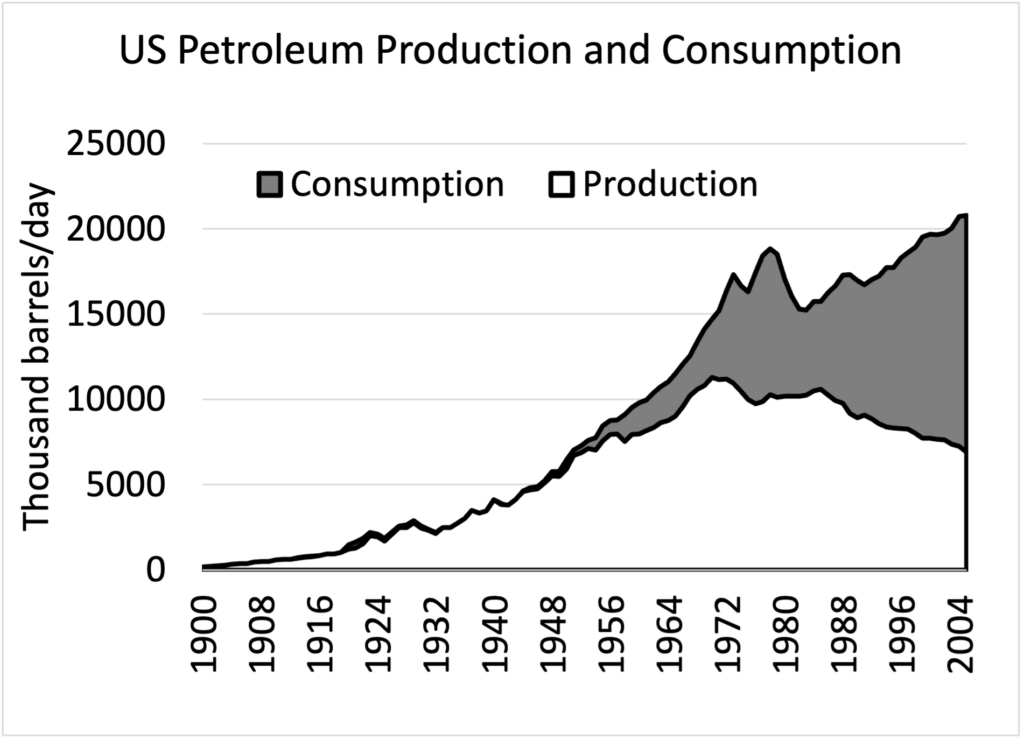
If you’re driving down the road and see plants growing in ditches and fence rows — at the edge zone between pastures and forest — you’re looking at a succession.
Disturbance can happen through fire, through glaciers, through overgrazing, through tillage. These events reset the stage for weedy pioneer species to flourish.
An aboveground plant succession is mirrored by a belowground soil food web succession. As the species move toward the climax prairie or climax forest, the soil becomes increasingly more fungal and complex.
Early on, at the pioneer level, you have very bacterial soil. Pioneer weeds respond to nitrates. They respond to raw humic substances, such as raw poultry manure.
As the ecosystem becomes increasingly more perennial — like a prairie or a forest — it is less disturbed and there’s greater deposition of ligno-cellulosic mulch. There’s greater fungal diversity and greater mycorrhizal fungae that associates with plants. A fascinating thing that I found through my fieldwork in Texas, through a lot of soil food web testing, is that prairies are fungal. This was a huge insight that serves as a road map for understanding how soil biological succession can be used as a tool in land management.
The point is that tillage continually disturbs the fungal succession, encourages bacterial blooms, and resets the stage for weedy pioneer species to flourish. It is an ecological imperative that when you cultivate the ground, you’re resetting the stage for weeds to grow. That is why weeds are growing — they’re responding to these signals from nature.
The other thing to point out is that you will always have a seed bank. Pigweed is common on our farm from past management practices. It was allowed to seed, which means we have enough pigweed seed to last for decades. This kind of a weed seedbank is universal to every farm. Whenever you have bare soil, sunlight and moisture, you’re guaranteed to have weeds.
Why do weeds do that? Because they have a purpose. There’s an old saying that goes back to Aristotle: “Nature abhors a vacuum.” Weeds have a role to play: they respond to these signals and recolonize the soil — they set the stage for ecological succession to occur.
Dr. Elroy Rice conducted abandoned field studies at the University of Oklahoma in the 1960s and ’70s. He would study abandoned farms and observe how plant succession took place over time. In Oklahoma, the prairie is a huge part of the native ecosystem.
Dr. Rice determined that there are four stages of prairie succession. The pioneer weed stage lasts for two or three years. Then there is an annual grass stage that lasts for nine to 13 years. Then there’s a perennial bunch-grass stage that lasts for 30 to 50 years. Finally, the land reverts back to a climax prairie. It takes a long time to achieve this.
He found this delayed succession was related to allelopathy. Allelopathy is the positive or negative affect of one plant on another through the production of chemical compounds called allelochemicals. They’re a driving mechanism for shifts in species composition and in the long duration of these vegetative stages. Dr. Rice wrote the bible on allelopathy — he’s the guy who figured it out, based on those prairie studies.
Allelochemicals are exuded in the rhizosphere. The rhizosphere is the zone right next to the root where living biology can extend several centimeters away from the root plane. Rhizodeposition is the technical term for root exudates — photosynthates are leaked out into the soil and feed the soil microbiology right next to the plant. The rhizosheath is the soil that clings to the rhizosphere.
Scientists have found out that there are at least two dozen different kinds of amino acids that leak out as root exudates — plus assorted amounts of sugars, vitamins, nucleic acids, enzymes, ions and gases.
Dr. Rice discovered that there are eight phenolic compounds exuded by leaves and roots of plants that inhibit nitrogen-fixing and nitrifying microorganisms, thereby delaying ecological succession of prairie species. These include chlorogenic acid, gallic acid, tannic acid, etc.
What this all boils down to is that if you’re working the soil — for example, to prepare a seedbed — you’re going to have weeds, because they will automatically respond to that ecological event. Therefore, you should plan to have integrated weed management strategies in place, such as mechanical cultivation, organic mulches, plastic mulches and crop rotations.
Weeds as Indicators of Soil Conditions
Most farmers understand that weeds are good indicators of soil conditions. When they look at a piece of land and see certain weeds, they automatically tie those weeds to soil and ecological site conditions.
When you see smartweed or curly dock or nutsedge on a farm, you automatically associate that with a moist soil. A dry soil, a compacted soil and an acid soil will all have specific plants growing there that tell us what’s going on with the land.
If you have an acidic pasture soil, you’ll often see broomsedge — commonly known as “sage grass” by farmers in the eastern U.S. High rainfall in this region leaches calcium, so the pH naturally drops. It’s very common to see pasturelands in Kentucky, Arkansas, and eastern Oklahoma — all the way to the East Coast — with a soil pH of 5.5. Broomsedge grows under these acidic, low-fertility conditions. It is a lower-quality, lower-successional forage.
Common Weeds in Different Soil Types
Weeds in Various Soil Types:
- Moist soil: smartweed, curly dock, nutsedge
- Acid soil: sorrel, blackberry, broomsedge
- Dry soil: black medic, prostrate pigweed
- Compacted soil: goosegrass, knotweed, prostrate spurge
- Shady areas: violets, nimblewill
- Fertile soil: lamb’s quarter, mullein
Resources on this Topic:
- Weeds and What They Tell Us by Ehrenfried Pfeiffer
- Weeds: Control without Poisons by Charles Walters
- When Weeds Talk by Jay McCaman
- The Use of Plant Indicators in Groundwater Surveys, Geological Mapping, and Mineral Prospecting by Helen Cannon
Ehrenfried Pfeiffer was a pioneer of biodynamic agriculture who started writing about this decades ago. Weeds and What They Tell Us was one of the first books to come out in the popular literature on weeds as indicators of soil conditions. But Pfeiffer also talked about dynamic plants, like chamomile and stinging nettle, that have properties that can influence other plants next to them in a positive way.
There’s a whole field of study called geobotany that looks at plants as indicators of geological conditions — what minerals can be found in the soil, what kind of wetland conditions are present. Geoprospecting looks for plants that indicate rare minerals, like gold and silver. There’s a certain moss that indicates where copper can be mined. For selenium, look for Astragalus — milk vetch. Vanadium is indicated by Amanita muscaria, a type of fungi.
Weeds as Mineral Accumulators
Weeds are also mineral accumulators.
Fertility Pastures by Newman Turner talks about herbal leys. An herbal ley is a pasture sown into a diverse mixture of grasses, herbs and legumes for the purpose of mining the soil for minerals. When livestock graze on these herbal leys they get a smorgasbord of minerals they need for their normal metabolism and health.
There’s a company in England, Cotswold Seeds, that sells the original Newman Turner herbal ley seeds. It includes a couple kinds of ryegrass, orchardgrass, Timothy grass, several kinds of fescues and white clovers, red clover, alsike clover, birdsfoot trefoil, sainfoin, sweet clover, burnet, chicory, yarrow and plantain. It creates a diverse forage mix, which livestock feed on. Animals have an incredible sense — way beyond our capabilities — of sensing and eating things that they need for their health.
An example of dynamic accumulation of minerals by weeds comes from a research article back in 1953. Onions were grown as the main crop, and then the researchers analyzed leaves from both the onions and the weeds that grew in that same field — pigweed, lamb’s quarter, smartweed, chickweed, purslane, crabgrass and barnyard grass.
The onion leaves had 2.0 percent nitrogen in its tissue. The purslane was twice that, at 4.3 percent.
For phosphorus, the onion had 0.28 percent. Pigweed and purslane were roughly twice that amount.
Potassium is a huge accumulator in plant tissue. The onion leaves had 2.23 percent, while purslane had at 8.43 percent. That’s almost four times greater than the onion crop.
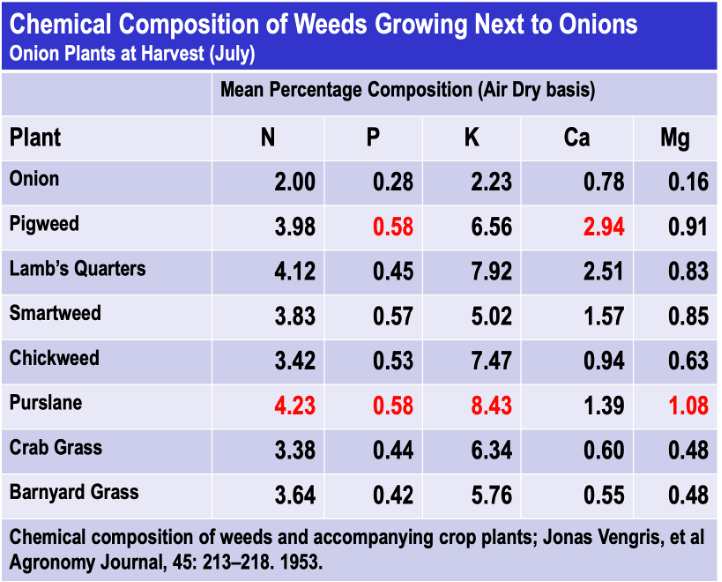
The first time I got interested in dynamic accumulators was when I was looking at potassium accumulation in leaves that could be harvested out of alligator weed in ponds, then dried and applied as a potassium fertilizer. It had about 7 percent potassium. When considering common organic fertilizers, that’s nothing to sneeze at.
Let’s compare the fertilizer value of commercial liquid organic fertilizers with liquid herbal teas you can make from on-farm fermentations and extracts using weedy plants. These kinds of biofertilizer preparations are gaining traction on a worldwide basis. This is done by stuffing leafy material from herbs and weeds into a barrel full of water and allowing it to ferment, then using the filtered extract as a liquid organic fertilizer.
Some of the common liquid organic fertilizers we use at our research farm are derived from liquid fish (2-4-1), soybean extract (3-1-1) and food waste biodigestate (3-2-2) — in the 2 to 3 percent nitrogen range. Researchers in Zimbabwe (“The Nutrient Content of Organic Liquid Fertilizers in Zimbabwe”) tried these weed tea methods and found that water hyacinth had a liquid fertilizer analysis of 3.7–2.7–2.9, pigweed was 1.5–2.9–2.0, and Russian comfrey was 2.9–2.9–3.9. That’s turning dynamic accumulators into a useful part of your fertility program.
Soil Management Strategies for Ecological Weed Suppression
Let’s discuss some soil management strategies for ecological weed suppression.
A common observation by farmers is that you’ll see a rapid flush of weeds following the application of raw poultry manure. Yet researchers who have dissected raw manure have found very few if any weed seeds — the gizzard crushes them up. However, if you take that same poultry manure, turn it into humified compost, and apply it out onto fields, you’ll see a delayed response in weed emergence. What’s going on here? What’s the difference between these two soil amendments?
This gets back to applied weed ecology. The weed seedbank responds to environmental cues — signals from Nature. In this instance, weeds respond to the nitrates and raw humic substances found in poultry manure; they view this as a kind of disturbance. In contrast, the humified compost sends out a different signal — it mimics a more mature soil succession.
Another concept growers should understand is the significance of balancing the minerals in your soil.
Acres U.S.A. readers know about William Albrecht and Carey Reams — the pioneer soil scientists who talked to farmers about how to test their soil and the importance of calcium. It’s widely known in agronomy that calcium flocculates the soil. It improves the soil structure and porosity and thereby provides this nice, porous habitat for the soil food web — the soil biology — to live in.
Conversely, high-magnesium soils tend to become more tight and more compacted, and high levels of exchangeable sodium can lead to dispersive soils and to loss of soil structure. When you see immediate puddling or slippery soils, this is often because of excess sodium.
Jim Porterfield, a certified crop advisor in Illinois, ran an experiment last year in which he band-applied pelletized limestone (98G) and pelletized gypsum (SO4) between rows of corn at a pretty high rate —almost 1,800 pounds — with a broadcast spreader, just on the soil.
The photos show Jim’s results, and he got some good weed-control benefits from applying the calcium. Look how clean his rows are where the calcium was applied, compared to the control. This is cutting edge — it’s not been proven yet — it’s something he’s experimenting with. He tried it this year at a lower rate and did not get the same benefit. I’m not saying this will work in every instance, but it does demonstrate the concept that minerals affect soil flocculation.

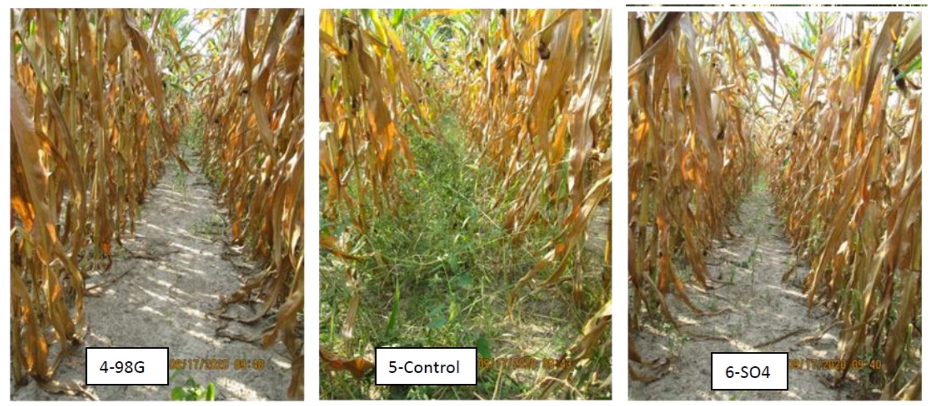
Another example comes from Crop Services International, which has traditionally emphasized the Carey Reams fertility scheme. Dr. Reams talked about the potassium-to-phosphorus ratio — it should be a minimum of 1:1, he said, but if you really want to control broadleaf weeds, you should aim for 2:1 or 4:1.
CSI tried this a few years ago with liquid calcium products mixed with molasses. They mixed 64 ounces of a phosphorus-calcium product with 2 gallons of blackstrap molasses and 20 gallons of water and sprayed it on the soil at cultivation. They achieved excellent weed suppression with this method.
One other technique is the use of weed-suppressive cover crops. They’re quick, they’re effective and they contribute different things to the soil. They exude chemicals or allelochemicals from their leaves and roots. They rapidly colonize and occupy the soil surface. They function as a smother crop. You want something that will establish quickly and cover the soil and that will gain a foothold before weeds germinate — this is the key. Clover, by the way, is not going to do that for you. Clover germinates too slowly.
Living-Mulch Cover Crops to Offset a Weedy Succession
Living-mulch cover crops are a final way to offset a weedy succession.
On the University of Kentucky Horticulture Research Farm in Lexington, we’ve got weeds. We’ve got plenty of them. We’ve got a seedbank. Mechanized weed control does a great job, but it of course encourages weeds, including pigweed.
But pigweed is incredible. Look at its root hairs — it’s going deep and it’s releasing organic acids and enzymes into the soil as exudates. It’s mineralizing the parent rock material and pulling up nutrients into the plant tissue.
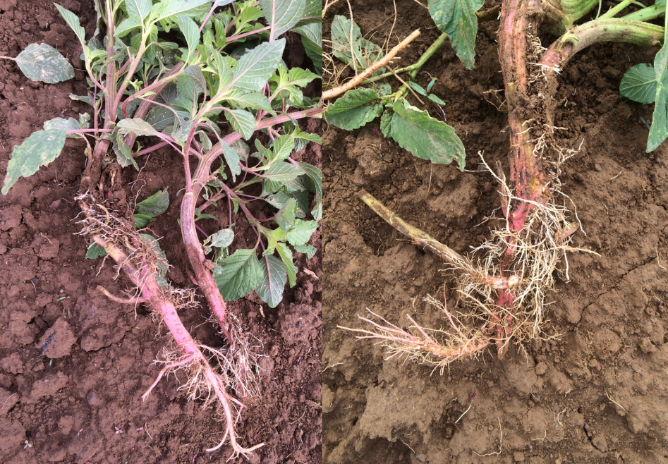
We also plant buckwheat on the side of our fields. Instead of leaving that area bare, to grow into a weedy succession that would have to be cultivated several times, it’s planted into a thick border of buckwheat. Buckwheat is a fast-growing cover crop that’s very weed suppressive. It has multiple benefits. It’s a great attractor of beneficial insects and honeybees.
We plant living mulches between our plasticulture beds. We get them established so thick that we have 95 percent weed control. Very little weeding is involved once you get this going. We commonly use teff grass in alleyways for warm-season crops. Teff has 1.3 million seeds per pound.
For garlic that will be harvested in June or July, we plant a living mulch of annual ryegrass and clover between the plasticulture in the fall. There is very little weeding involved, and there are huge ecological benefits — keeping the soil covered, feeding the soil, keeping the soil alive, managing organic matter, providing habitat for insects, etc.
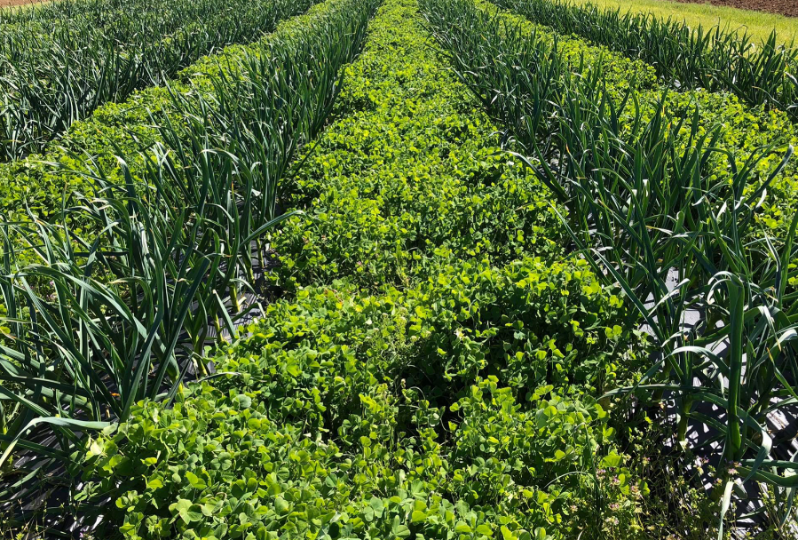
An important point is that if you want to establish a living-mulch cover crop, take the seeding rate from the seed company or the extension bulletin and double or triple the rate. You want to put out a bunch of seed to get it established very fast — to cover the ground and offset a weedy succession.
The last thing I want to mention is what is known as the “cropping system effect.” On our farm, for example, the cropping system effect is the sum of all the weed-control measures we employ. Soil preparation and organic matter management play a role in our weed control. We do multi-species cover crops; whenever we can insert a cover crop, there’s a cover crop growing on that ground, if vegetables are not growing there. We apply compost in the fall. We have a mechanized weed-control setup, with subsurface drip irrigation, a stale seedbedder, a basket weeder, and a finger weeder. We plant living-mulch cover crops — both cool season (annual ryegrass and clover) and warm season (teff, spring barley, cowpeas and buckwheat).
All of these methods do their part to help control weeds.
Steve Diver is the farm superintendent of the horticulture research farm at the University of Kentucky. He started attending Acres U.S.A conferences in 1985.













